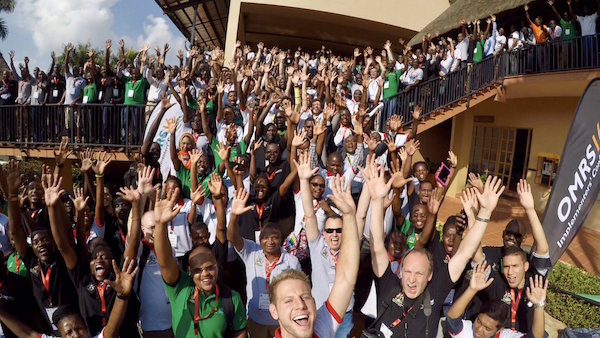OSEHRA 2017: Open Source Becomes Mainstream in the Healthcare Industry
Note: This is part 2 of what was a more extensive article reporting on the OSEHRA 2017 Summit. After publishing the article we received several emails and phone calls from great friends of Open Health News who suggested that the article was covering too many themes in one article, so we have decided to break it up into three parts. This is the second part. The first part is here. It is focused on the reports on the advances of open source health IT solutions throughout the world. Roger A. Maduro, Publisher and Editor-in-Chief.
 David PeraraOne of the most exciting things about the OSEHRA 2017 Open Source Summit was to see so many leading edge open source health IT solutions, and to hear reports of the major strides they are making around the world. Our very own Editor-in-Chief, Roger A. Maduro gave a presentation on the state of open health IT.
David PeraraOne of the most exciting things about the OSEHRA 2017 Open Source Summit was to see so many leading edge open source health IT solutions, and to hear reports of the major strides they are making around the world. Our very own Editor-in-Chief, Roger A. Maduro gave a presentation on the state of open health IT.
The room was absolutely packed, with standing room only. Maduro started his presentation by pointing out that during the recent HIMSS17 conference in Orlando, Florida, more than half of of the 300 sessions of the conference were based on open source solutions such as FHIR, Blockchain, Interoperability and the open/modular IT strategy being followed by Medicaid. The HIMSS Exhibition hall also had a large number of vendor booths with open health IT solutions.
Next, Maduro mentioned the success of VistA in the private sector and in foreign countries.He pointed out that VistA is the world’s leading hospital-based EHR. It is used at over 1,800 VA medical facilities. In addition VistA has been adopted in more than 1,500 private and public sector medical facilities around the world.
To provide a scope of its worldwide distribution, Maduro cited how the open source EHR is being deployed in the Hashemite Kingdom of Jordan. VistA is already running at over 75% of all medical facilities in Jordan, a nation of more than 10 million people. In addition Jordan is providing a safe refuge for several million refugees.
Full implementation of VistA across the medical facilities throughout the entire Kingdom should be finished by the end of next year. An all for less than 30 million dollars. The world’s most advanced EHR deployed in an entire country for less than the cost of implementing a vendor/lock-in EHR in one medium-sized rural hospital in the United States! The benefits are clear, VistA is consistently rated the best EHR in surveys by physicians and nurses year after year.
Another major milestone that Maduro mentioned was the 2016 OpenMRS Implementers meeting in Kampala, Uganda last December. As this meeting report details, the meeting was officially hosted by the Government of Uganda. It was attended by more than 400 participants, and there were official representatives from 26 countries. Uganda is one of more than 30 nations looking to carry out large-scale public/private sector OpenMRS implementations. The Ugandan government had already implemented OpenMRS in more than 500 clinics across the country and wanted to see if OpenMRS could become the national health IT platform.
 2016 OpenMRS Implementers meeting in Kampala, Uganda
2016 OpenMRS Implementers meeting in Kampala, Uganda
So the Ugandan government hosted the OpenMRS Implementers meeting to bring the world’s leading OpenMRS experts to Uganda to meet and collaborate with Uganda’s OpenMRS community. This effort was such a success that before the end of the meeting, the government of Uganda officially announced the decision that OpenMRS was going to be the nation’s health IT platform. Seeing the success of the Ugandan OpenMRS Implementers meeting, so many other countries volunteered to host the next OpenMRS Implementers meeting that the OpenMRS Foundation had to publish a set of requirements as well as a host country application so they could make a fair decision as to the next conference location.
Maduro also mentioned the rise of the OpenEMR community as a major open health solution in the United States and across the world. The OpenEMR community, which has more than 40 solution providers implementing the open source EHR, is maturing into a full-blown open source community with the members increasingly collaborating in major efforts. In March, the organization announced that OpenEMR had achieved complete meaningful use certification with the release of version 5.0 of their EHR software platform.
Next, the community came together to respond to a U.S. Coast Guard Request For Information (RFI) to replace the Coast Guard’s failed vendor lock-in proprietary EHR implementation. The OpenEMR community then published their response to the Coast Guard RFI. The response was covered by Arthur Allen from Politico who was very impressed that the proposed price tag for a Coast Guard OpenEMR would be less than $3 million. It should be pointed out that the OpenEMR community has already accomplished something similar. The Peace Corps successfully implemented OpenEMR throughout every Peace Corps post around the world four years ago. Today there are Peace Corps posts running OpenEMR in 77 countries.
- Tags:
- 2016 OpenMRS Implementers meeting
- Arthur Allen
- Blockchain
- David Perara
- FHIR
- Health IT
- healthcare industry
- HIMSS17 conference
- interoperability
- Kingdom of Jordan
- meaningful use certification
- Medicaid
- open health
- Open Health News
- open source
- open source community
- open source EHR
- open source software
- open source solutions
- open/modular IT strategy
- OpenEMR
- OpenEMR community
- OpenMRS
- OpenMRS Foundation
- OSEHRA 2017 Summit
- OSEHRA2017
- Politico
- Roger A. Maduro
- Uganda
- US Coast Guard
- US Peace Corps
- VistA
- Login to post comments